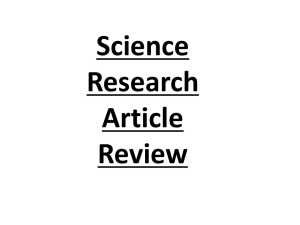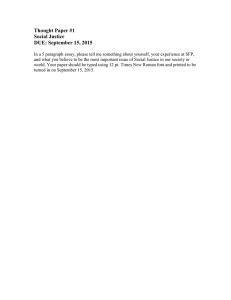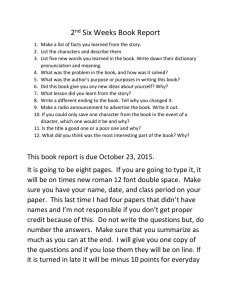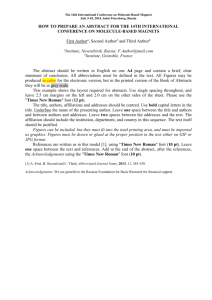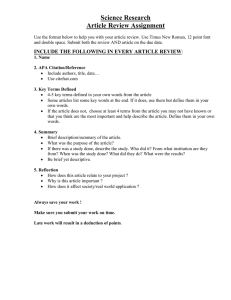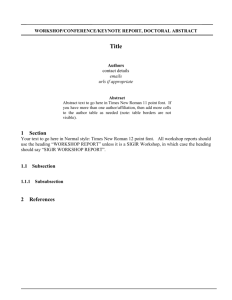INSTRUCTIONS FOR PAPERS AND POSTERS
advertisement
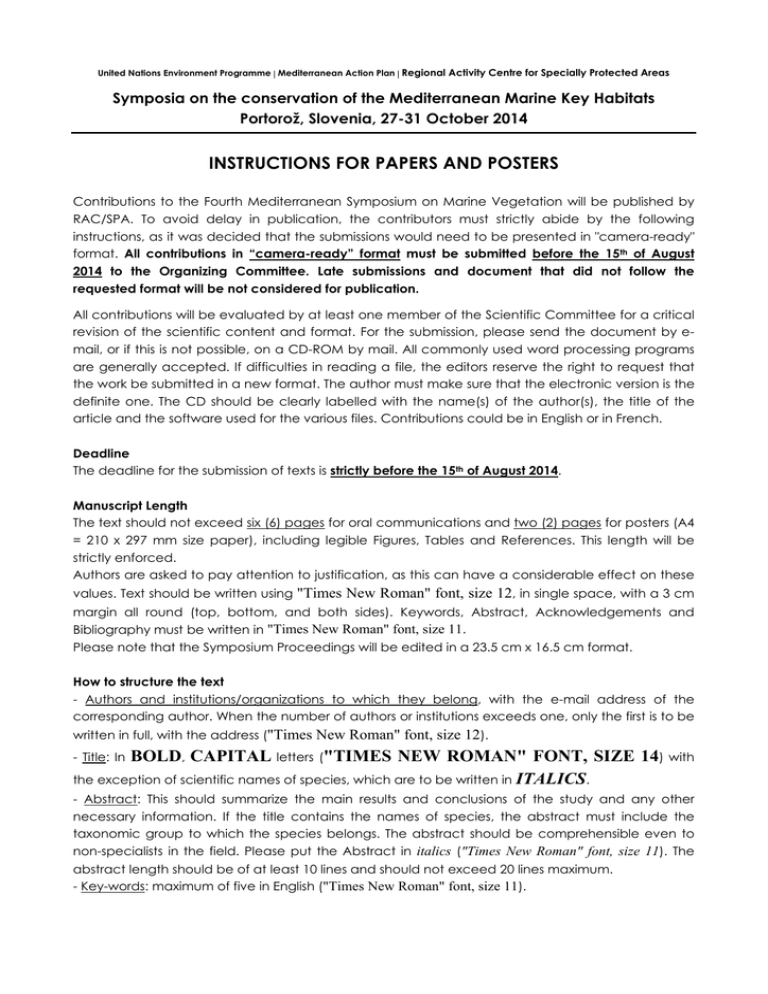
United Nations Environment Programme Mediterranean Action Plan Regional Activity Centre for Specially Protected Areas Symposia on the conservation of the Mediterranean Marine Key Habitats Portorož, Slovenia, 27-31 October 2014 INSTRUCTIONS FOR PAPERS AND POSTERS Contributions to the Fourth Mediterranean Symposium on Marine Vegetation will be published by RAC/SPA. To avoid delay in publication, the contributors must strictly abide by the following instructions, as it was decided that the submissions would need to be presented in "camera-ready" format. All contributions in “camera-ready” format must be submitted before the 15th of August 2014 to the Organizing Committee. Late submissions and document that did not follow the requested format will be not considered for publication. All contributions will be evaluated by at least one member of the Scientific Committee for a critical revision of the scientific content and format. For the submission, please send the document by email, or if this is not possible, on a CD-ROM by mail. All commonly used word processing programs are generally accepted. If difficulties in reading a file, the editors reserve the right to request that the work be submitted in a new format. The author must make sure that the electronic version is the definite one. The CD should be clearly labelled with the name(s) of the author(s), the title of the article and the software used for the various files. Contributions could be in English or in French. Deadline The deadline for the submission of texts is strictly before the 15th of August 2014. Manuscript Length The text should not exceed six (6) pages for oral communications and two (2) pages for posters (A4 = 210 x 297 mm size paper), including legible Figures, Tables and References. This length will be strictly enforced. Authors are asked to pay attention to justification, as this can have a considerable effect on these values. Text should be written using "Times New Roman" font, size 12, in single space, with a 3 cm margin all round (top, bottom, and both sides). Keywords, Abstract, Acknowledgements and Bibliography must be written in "Times New Roman" font, size 11. Please note that the Symposium Proceedings will be edited in a 23.5 cm x 16.5 cm format. How to structure the text - Authors and institutions/organizations to which they belong, with the e-mail address of the corresponding author. When the number of authors or institutions exceeds one, only the first is to be written in full, with the address ("Times New Roman" font, size 12). - Title: In BOLD, CAPITAL letters ("TIMES NEW ROMAN" FONT, SIZE 14) with the exception of scientific names of species, which are to be written in ITALICS. - Abstract: This should summarize the main results and conclusions of the study and any other necessary information. If the title contains the names of species, the abstract must include the taxonomic group to which the species belongs. The abstract should be comprehensible even to non-specialists in the field. Please put the Abstract in italics ("Times New Roman" font, size 11). The abstract length should be of at least 10 lines and should not exceed 20 lines maximum. - Key-words: maximum of five in English ("Times New Roman" font, size 11). Subdivisions of the text The headings for each section must be written in bold ("Times New Roman" font, size 12). The following order must be respected (optional sections, i.e. those not usually required for publications, are given in brackets): AUTHORS/affiliations TITLE Abstract (character size 12) Key-words (character size 12) Introduction (character size 12) Materials and methods (character size 12) Results (character size 12) Discussion and/or conclusions (character size 12) (Acknowledgments) (character size 12) Bibliography (character size 12) Figures and Tables These should be inserted in the right position in the text. They are to be calculated as part of the available space. Remember that the width of the printed page is 18 cm, and this limit also applies to the space available for figures and tables. The legends must be placed above the tables and under the figures, and written in "Times New Roman" bold font, size 11, in single space. Be careful not to use characters that are either too large or too small in relation to the figure. By way of an example, we should point out that an 18 cm wide table written in Word will remain easily readable when reduced by the printer to the 13 cm of the printed page, but further reductions are not possible. Figures and tables must be enclosed as separated files. They must be numbered, using progressive Arabic numbers (Tab. 1, Fig. 1, etc.). References to figures or tables should always be made in the text. References Bibliographical references must be put in alphabetical order. The bibliography should contain only works quoted in the text. Do not quote abstracts. Quotations in the text should be as follows: (Barrois, 1977; Uchiyama & Shomura, 1974; Uchiyama et al., 1980) (Flamigni, 1984; 1987). The following model should be adhered to with extreme care (especially with regard to the use of italics): CAVALIERE A. (1963) - Studi sulla biologia e pesca di Xiphias gladius L. Nota II. Boll. Pesca Piscic. Idrobio., 18 (2) : 143-170. ARTHUR W. (1987) - The niche in competition and evolution. Wiley and Sons, Chichester: 175 pp. GARAY I., NATAF L. (1982) - Microarthropods as indicators of human trampling in suburban forests. In: Bornkamm R., Lee J.A., Seaward M.R.D. (eds), Urban Ecology, Blackwell Scientific Publications, Oxford: 201-207. The second line should indent of 0.5 cm Photos and colour tables It is recommended that only black and white photos be submitted. Colour tables and photos will only be accepted if strictly necessary to outline the results, and after prior agreement by the Editorial Board.
